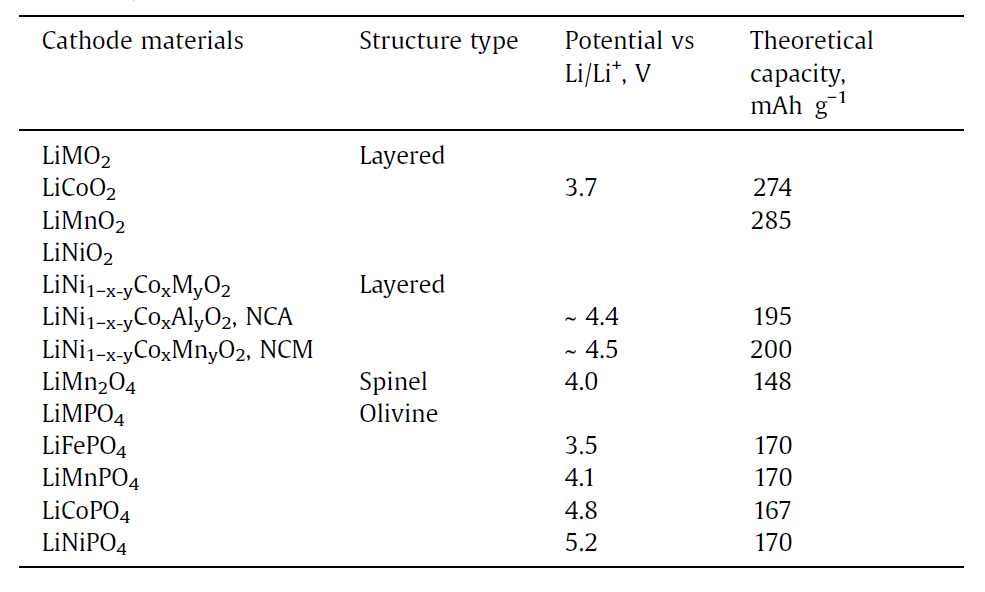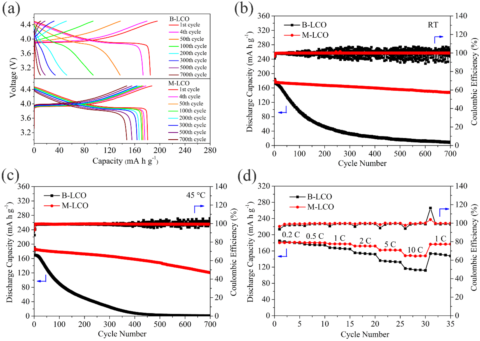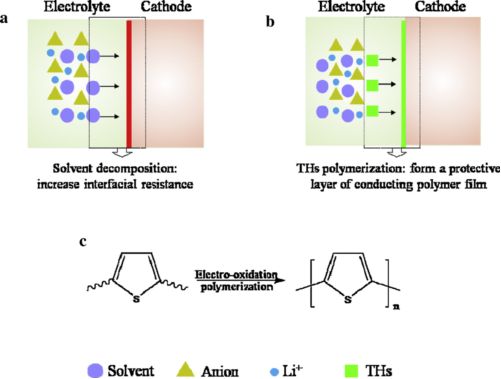Research Progress of High-Voltage Lithium-Ion Battery Materials

Introduction
Lithium- ion batteries (LIBs) are widely used in a wide range of applications due to their high energy density, high Coulombic efficiency, low self-discharge characteristics, and a range of chemical potentials obtainable with different electrode designs. With the rapid development of people's economy and lifestyle, the application field of lithium-ion batteries has been further expanded, which also puts forward new requirements for its performance. There are many key parameters in lithium-ion batteries, and the energy density and battery capacity of batteries are among them. part. The energy density of Li-ion batteries can be increased by either increasing the operating voltage or the charge storage capacity. However, since the working voltage of the most common graphite anode is close to the Li/Li?+?potential. Therefore, the only option to increase the battery voltage is to increase the operating voltage of the positive electrode. Currently, there are three cathode structures (layered, spinel, and olivine) that offer high operating voltages (~4.3V vs Li/Li+)?[1,2]?and are receiving extensive attention. This paper introduces the synthesis and research progress of three cathode materials with layered, spinel and olivine structures, and provides ideas for related research.

Fig.1?Crystal structures of three different types of cathode materials

Table 1:?Comparison of electrochemical characteristics of mainstream commercial cathode materials?[3]
Spinel Structure
spinel cathode material LiMn1.5Ni0.5O4 is considered as an advanced lithium-ion battery material and has received major research attention due to its high operating voltage (about 4.8 V) (Fig. 1). Since LiyNi1?yO(impurity) exists as a second phase, which affects the electrochemical behavior, it is difficult to synthesize pure Li1?x[Ni0.5Mn1.5]O4 spinel with stoichiometric properties [4,5] . LiMn1.5Ni0.5O4 has two different crystal structures: (i) a stoichiometric ordered structure consisting only of Mn4+, and (ii) a non-stoichiometric disordered structure consisting of Mn3+ and Mn4+ composition, face centered cubic structure (Fd3m). The ordered phase (LiMn1.5Ni0.5O4 ) is an original simple cubic structure (P4332), in which Ni, Mn and Li atoms occupy the 4a, 12d and 8c positions, respectively, while the O atoms are located at the 8c and 24e positions. The non-chemical structure (LiNi0.5Mn1.5O4-δ) is a face-centered cubic structure (Fd3m) , in which Ni and Mn atoms are randomly distributed on the 16d site, while Li and O atoms occupy the 8a and 32e sites, respectively. In the preparation of these two crystal structures, the annealing temperature is critical [6].
Despite the many advantages of LiMn1.5Ni0.5O4, many obstacles are still encountered in high-rate applications. Jafta et al. studied the influence of microwave radiation on Mn 3+ concentration and electrochemical performance in LiMn1.5Ni0.5O4 spinel [6]. The results show that microwaves are able to tune the Mn content in spinel to enhance the electrochemical performance (high capacity, high retention, excellent rate capability and fast Li+ insertion/extraction kinetics). This discovery is expected to revolutionize the application of microwave irradiation to enhance the performance of LiMn1.5Ni0.5O4?spinel, especially in high-rate applications.

Fig.2 Morphology and discharge performance comparison of LiMn1.5Ni0.5O4 before and after microwave treatment
Olivine Structure
Olivine-structured cathode materials have attracted extensive attention from researchers because of their superior safety, large reversibility, high optimization potential, wide energy density, and high-power application capabilities. In the olivine structure, one MO6 octahedron is connected with two LiO6 octahedrons and one PO4 tetrahedron [7]. Ion diffusion in the crystal occurs in the 1D pathway (010) [8], which hinders the rapid insertion and extraction of ions due to the separation of MO 6 octahedral and LiO6 tetrahedral polyanions. The ordered olivine structure of LiMPO4 is obtained from transition d metals such as iron (Fe), manganese (Mn), cobalt (Co), and nickel (Ni) [8,9].
The current technical problems of olivine structure mainly focus on two aspects of cycle stability and rate performance [7,10,11]. These shortcomings can be improved by reducing particle size [7,9,10,12,13], doping other d elements [7,8] and carbon coating [13-19]. In addition, the surface modification technology can also avoid the direct contact between the positive electrode and the organic electrolyte, thus preventing the degradation of the positive electrode, because the positive electrode can react with HF, the product of electrolyte decomposition [20,21].
Layered Structure
Owing to high energy density, low cost, and environmental friendliness, Ni-rich layered transition metal oxides are considered to be extremely promising cathode candidates for building next-generation Li-ion batteries to meet the demands of electric vehicles. However, there are still some problems in terms of rate performance, structural stability, and safety, which hinder the practical application of this technology. Until now, it still plays an important role in the lithium-ion battery market. Due to these advantages, it is an irresistible development trend to further increase the charge cut-off voltage of LiCoO2?to ensure higher energy density. However, using too high a charge cut-off voltage may cause many negative effects, especially the rapid fading of the cycle capacity. This is mainly due to the rapid destruction of the crystal structure and the intensification of interfacial side reactions at high pressure during cycling. Therefore, how to maintain the stable crystal structure of LiCoO2?while ensuring the excellent long - period performance under high pressure is a hot research issue in LiCoO2?applications.
Guo et al. developed a one-step comprehensive co-modification method to achieve long cycle life of LiCoO2?in the range of 3.0–4.5?V. In this study, the phosphoric acid?surface layer suppressed the electrolyte side reactions and Co dissolution, and the doping of Mn improved the structural stability of LiCoO2. The results showed that the capacity retention of modified LiCoO2?was as high as 83.7% after 700 cycles when the cut-off voltage was 4.5 V [22].

Fig.3:Electrochemical performance diagram of modified LiCoO2 material
Thiophene derivatives (THs) as a novel functional additive have been used to improve the cycle performance of high-pressure LiCoO2.?Studies by Liu et al. have shown that 2,20-bithiophene (2TH) and 2,20:50,20-terthiophene (3TH) can be electrochemically polymerized before the electrolyte solvent is decomposed to form a conductive polymer protective layer on the surface of the positive electrode. A thin film prevents severe decomposition of the electrolyte under high pressure, thus improving the cycle stability of high LiCoO2?cathodes?[23].
Fig. 4?Schematic model of the high-potential cathode surface in a liquid electrolyte without additives
The results showed that after 100 cycles at a high cut-off voltage of 4.4 V, the discharge capacity retention in the base electrolyte was 50%, while the LiCoO2?cathode cycled in the electrolyte containing 0.1 wt?% 3TH was at a rate of 0.25 C. The discharge capacity retention rate was 84.8%. This work also demonstrates the considerable potential of thiophene derivatives as functional additives in high-voltage Li- ion batteries.

Fig.5?Cycle performance diagram of Li/LiCoO2 battery in 1 molL-1 LiPF6 /EC+DMC (3/7, v/v) additive-free electrolyte solution (current density 0.25 C, cut-off voltage 3.0-4.4 V)
References
[1] Julien C M, Mauger A, Zaghib K, et al. Comparative issues of cathode materials for Li-ion batteries[J]. Inorganics, 2014, 2(1): 132-154.?https://doi.org/10.3390/inorganics2010132
[2] Bruce P G. Solid-state chemistry of lithium power sources[J]. Chemical Communications, 1997 (19): 1817-1824.https://pubs.rsc.org/en/content/articlehtml/1997/cc/a608551b
[3] Tolganbek N, Yerkinbekova Y, Kalybekkyzy S, et al. Current state of high voltage olivine structured LiMPO4?cathode materials for energy storage applications: A review[J]. Journal of Alloys and Compounds, 2021, 882: 160774. https://doi.org/10.1016/j.jallcom.2021.160774
[4] Liu J, Manthiram A. Understanding the improved electrochemical performances of Fe-substituted 5 V spinel cathode LiMn1.5Ni0.5O4[J]. The Journal of Physical Chemistry C, 2009, 113(33): 15073-15079.?https://doi.org/10.1021/jp904276t
[5] Liu D, Han J, Goodenough J B. Structure, morphology, and cathode performance of Li1?x?[Ni0.5Mn1.5] O4?prepared by coprecipitation with oxalic acid[J]. Journal of Power Sources, 2010, 195(9): 2918-2923.?https://doi.org/10.1016/j.jpowsour.2009.11.024
[6] Jafta C J, Mathe M K, Manyala N, et al. Microwave-assisted synthesis of high-voltage nanostructured LiMn1.5Ni0.5O4?spinel: tuning the Mn3+?content and electrochemical performance[J]. ACS applied materials & interfaces, 2013, 5(15): 7592-7598.?https://doi.org/10.1021/am401894t
[7] Yamada A, Hosoya M, Chung S C, et al. Olivine-type cathodes: Achievements and problems[J]. Journal of Power Sources, 2003, 119: 232-238.https://doi.org/10.1016/S0378-7753(03)00239-8
[8] Sgroi M F, Lazzaroni R, Beljonne D, et al. Doping LiMnPO4?with cobalt and nickel: a first principle study[J]. Batteries, 2017, 3(2): 11.https://doi.org/10.3390/batteries3020011
[9] Zaghib K, Guerfi A, Hovington P, et al. Review and analysis of nanostructured olivine-based lithium recheargeable batteries: Status and trends[J]. Journal of Power Sources, 2013, 232: 357-369.https://doi.org/10.1016/j.jpowsour.2012.12.095
[10] J.B. Goodenough, Cathode materials: a personal perspective, J. Power Sources 174 (2007) 996–1000, https://doi.org/10.1016/j.jpowsour.2007.06.217
[11] M.M. Doeff, J.D. Wilcox, R. Kostecki, G. Lau, Optimization of carbon coatings on LiFePO4, J. Power Sources 163 (2006) 180–184, https://doi.org/10.1016/j. jpowsour.2005.11.075
[12] Zhang H, Gong Y, Li J, et al. Selecting substituent elements for LiMnPO4?cathode materials combined with density functional theory (DFT) calculations and experiments[J]. Journal of Alloys and Compounds, 2019, 793: 360-368. https://doi.org/10.1016/j.jallcom.2019.04.191
[13] J. Li, W. Yao, S. Martin, D. Vaknin, Lithium-ion conductivity in single crystal LiFePO4, Solid State Ion. 179 (2008) 2016–2019, https://doi.org/10.1016/j.ssi. 2008.06.028
[14] H.-C. Dinh, I.-H. Yeo, W. Il Cho, S. Mho, Characteristics of conducting polymer- coated nanosized LiFePO4?cathode in the Li+?batteries, ECS Trans. 28 (2019) 167–175, https://doi.org/10.1149/1.3490696
[15] S.L. Bewlay, K. Konstantinov, G.X. Wang, S.X. Dou, H.K. Liu, Conductivity improvements to spray-produced LiFePO4 by addition of a carbon source, Mater. Lett. 58 (2004) 1788–1791, https://doi.org/10.1016/j.matlet.2003.11.008
[16] M. Safari, C. Delacourt, Modeling of a commercial graphite/LiFePO4?cell, J. Electrochem. Soc. 158 (2011) A562, https://doi.org/10.1149/1.3567007?
[17] Y. Hu, M.M. Doeff, R. Kostecki, R. Fi?ones, Electrochemical performance of sol- gel synthesized LiFePO4?in lithium batteries, J. Electrochem. Soc. 151 (2004) A1279, https://doi.org/10.1149/1.1768546?
[18] V. Srinivasan, J. Newman, Existence of path-dependence in the LiFePO4?electrode, Electrochem. Solid-State Lett. 9 (2006) A110, https://doi.org/10.1149/1.2159299?
[19] C. Gong, Z. Xue, S. Wen, Y. Ye, X. Xie, Advanced carbon materials/olivine LiFePO4?composites cathode for lithium-ion batteries, J. Power Sources 318 (2016) 93–112, https://doi.org/10.1016/j.jpowsour.2016.04.008
[20] N. Laszczynski, A. Birrozzi, K. Maranski, M. Copley, M.E. Schuster, S. Passerini, Effect of coatings on the green electrode processing and cycling behaviour of LiCoPO4, J. Mater. Chem. A 4 (2016) 17121–17128,?https://doi.org/10.1039/ c6ta05262b
[21] S.M. Oh, S.T. Myung, Y.K. Sun, Olivine LiCoPO4-carbon composite showing high rechargeable capacity, J. Mater. Chem. 22 (2012) 14932–14937, https://doi.org/ 10.1039/c2jm31933k
[22] Gu R, Qian R, Lyu Y, et al. One-step integrated comodification to improve the electrochemical performances of high-voltage LiCoO2?for lithium-ion batteries[J]. ACS Sustainable Chemistry & Engineering, 2020, 8(25): 9346-9355. https://doi.org/10.1021/acssuschemeng.0c01491
[23] Xia L, Xia Y, Liu Z. Thiophene derivatives as novel functional additives for high-voltage LiCoO2?operations in lithium-ion batteries[J]. Electrochimica Acta, 2015, 151: 429-436.?https://doi.org/10.1016/j.electacta.2014.11.062
 首页
首页 400-620-6333
400-620-6333



 危险品化学品经营许可证(带存储)
危险品化学品经营许可证(带存储)